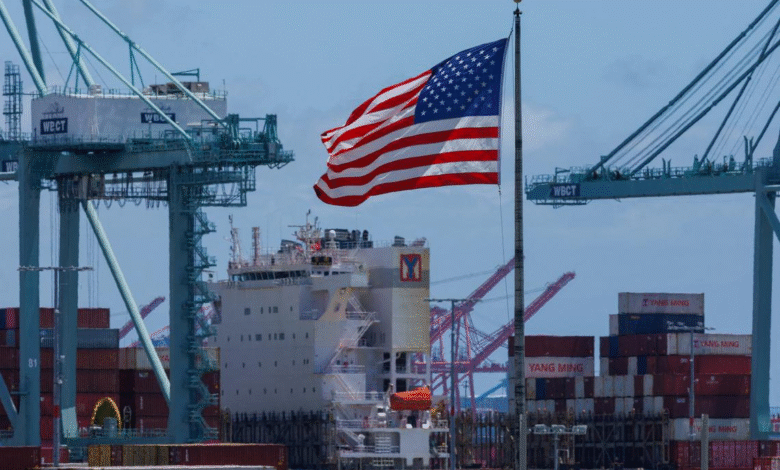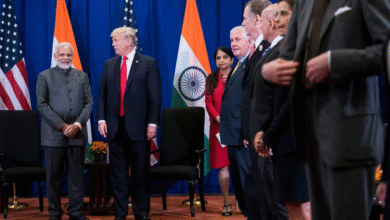Trump Vietnam Trade Deal: New Tariffs and Market Access Explained

The recent Trump Vietnam trade deal marks a significant shift in trade relations between the United States and Vietnam, as President Donald Trump announced a 20% tariff on imports from Vietnam aimed at boosting U.S. economic interests. This move, shared on Trump’s platform, Truth Social, promises to provide the U.S. with unprecedented access to the Vietnamese market without tariff barriers. Additionally, the agreement’s stipulation of imposing a hefty 40% tariff on transshipping tariffs highlights the U.S. administration’s commitment to combat potential trade loopholes. As Vietnam’s exports account for a substantial portion of its GDP, the implications of these Vietnam tariffs are profound, potentially reshaping trade dynamics in the region. Amidst growing concerns about how this trade agreement will influence overall U.S. trade agreements, the response from market analysts remains cautiously optimistic, reflecting on the interplay between tariff policies and consumer prices.
In a transformative move for U.S.-Southeast Asia relations, the recent trade agreement between Trump and Vietnam aims to redefine import-export dynamics. By implementing a significant 20% tariff on goods entering the U.S. from Vietnam, this arrangement promises to enhance market access for American products while safeguarding domestic industries. Additionally, the controversial practice of transshipping—where goods are rerouted through Vietnam to bypass tariffs—will be met with tough penalties under this deal. As discussions surrounding tariffs evolve, many are left to ponder the broader implications for economic stability within the context of U.S. trade agreements. The integration of these trade measures signals a potential shift in how the U.S. navigates its relationships with foreign markets, particularly in addressing contentious trade practices.
Impact of the Trump Vietnam Trade Deal on Tariffs
The recently announced Trump Vietnam trade deal is poised to significantly alter the landscape of U.S.-Vietnam trade. By imposing a 20% tariff on imports from Vietnam, the deal aims to balance trade discrepancies while giving U.S. companies direct access to Vietnamese markets. This strategic shift not only increases the cost burden on U.S. importers but also places pressure on consumers who may see higher retail prices as a direct consequence of increased tariffs. Importers will likely need to adjust their pricing strategies to absorb or pass on these costs, which could lead to a ripple effect across various sectors of the economy.
Additionally, the emphasis on a 40% tariff on transshipped goods raises critical concerns about compliance and enforcement. Transshipping, where goods are routed through a third country to evade tariffs, poses a challenge to maintaining trade integrity. Trump’s firm stance on transshipping tariffs indicates a commitment to enforcing trade regulations, thereby ensuring that the intended economic benefits of the deal are realized. The potential fallout from these tariffs could result in increased operational costs for companies relying on Vietnamese imports, leading to a reevaluation of sourcing strategies.
Vietnam Market Access: A New Era of Trade Relations
President Trump’s assertion that the trade deal will provide the United States with total access to Vietnam’s markets marks a pivotal moment in trade relations between the two countries. This unrestricted access allows U.S. companies to export goods into Vietnam without the burden of tariffs, which is a significant development for American businesses looking to penetrate the Southeast Asian market. Industries ranging from agriculture to technology stand to benefit immensely from this arrangement, as it opens a pathway to a rapidly growing consumer base.
However, the effectiveness of this market access hinges on Vietnam’s willingness to adopt fair trade practices and adhere to the stipulated terms of the agreement. Vietnam’s commitment to zero tariffs on U.S. exports could incentivize further investment and cooperation, enhancing economic ties and leading to bilateral growth. Success in this domain may ultimately serve as a blueprint for future U.S. trade agreements, illustrating how countries can navigate complex tariff structures while fostering mutual economic benefits.
The Role of Trump Truth Social in Announcing Trade Deals
Trump utilized his social media platform, Truth Social, to publicly announce the trade deal with Vietnam, showcasing its role as a vital communication tool in contemporary politics. This direct line of communication allows Trump to reach supporters and stakeholders instantly, framing the narrative around his administration’s trade policies and decisions. By leveraging such platforms, Trump not only informs the public but also garners support for his initiatives, creating a feedback loop between him and his audience.
Moreover, the strategic use of social media during announcements like the Trump Vietnam trade deal emphasizes the increasing importance of digital platforms in shaping public perception of governmental actions. Each tweet or post adds layers to the ongoing narrative of his administration’s efforts in addressing trade imbalances and economic policy, often stirring reactions from critics and supporters alike. In a landscape rife with information, platforms like Truth Social serve as battlegrounds for opinions on tariffs, trade agreements, and other vital economic discussions.
Vietnam Tariffs: Economic Implications for Consumers
The imposition of a 20% tariff on Vietnamese goods is expected to have substantial implications for U.S. consumers, particularly in everyday spending categories. As companies face elevated import costs due to tariffs, these expenses are likely to trickle down to consumers, translating into higher retail prices. For instance, studies have indicated that a simple article like a men’s sweater could see price increases of significant percentages, depending on the tariff rate applied. This potential spike in consumer prices calls into question the affordability of goods, particularly for lower-income households.
Moreover, economic analysts have begun to monitor price trends and inflationary pressures in sectors heavily reliant on Vietnamese imports. While there may have been some buffering effects from companies stockpiling goods prior to the tariff implementation, as those inventories dwindle, the true impact on prices is expected to crystallize in the coming months. This reality could lead to a reassessment of consumer spending habits, as higher costs could either deter discretionary purchases or prompt consumers to seek alternatives, illustrating the far-reaching effects of tariff policies.
Transshipping Tariffs: Combating Evasive Trade Practices
The introduction of a 40% tariff on transshipped goods within the Trump Vietnam trade deal underscores the administration’s focus on curbing evasive trade practices. Transshipping often operates as a loophole, allowing goods to circumvent tariffs by being routed through a different country. By imposing hefty tariffs on these products, the U.S. aims to discourage such practices that undermine fair trade. This move is seen as a critical step in safeguarding American industries that could suffer from unfair competition.
In addition, the implementation of these transshipping tariffs presents challenges for importers who must ensure compliance with trade regulations while navigating complex supply chains. Firms will need to be vigilant in tracking the origin of their imports to avoid incurring unexpected duties, which could significantly alter their cost structures and operational logistics. As the administration tightens its regulatory grip, companies must adapt swiftly to avoid penalties that could impact their bottom line.
Bilateral Relations: The Future of U.S.-Vietnam Trade
The trade deal signals a deepening of bilateral relations between the United States and Vietnam, aiming to foster economic cooperation while addressing trade imbalances. Both nations stand to benefit from an enhanced economic partnership, as Vietnam continues to develop as a global manufacturing hub. Expanding trade ties could lead to increased foreign direct investment from the U.S., benefitting sectors such as infrastructure, renewable energy, and mobile technology.
Going forward, the U.S. must balance its tariffs and trade agreements carefully to ensure they do not harm the potential growth promised by these partnerships. As the U.S. continues to renegotiate trade agreements with other countries, including China and the UK, maintaining strong relations with Vietnam will be pivotal. The effectiveness of these bilateral deals will ultimately depend on sustained communication and mutual respect in trade negotiations.
Consumer Sentiment Amidst Tariff Changes
As news of the Trump Vietnam trade deal spreads, consumer sentiment is expected to fluctuate in response to the anticipated changes in import tariffs. With tariffs typically leading to increased product prices, shoppers may begin to reconsider their purchasing priorities. Economic stakeholders are acutely aware that consumer confidence is vital for market stability; thus, any significant shift in consumer behavior stemming from tariff changes could have long-term repercussions for various industries.
Furthermore, understanding consumer sentiment will be crucial for retailers and businesses strategizing to mitigate the effects of rising prices. Companies may need to invest in marketing campaigns that emphasize value and affordability to retain customer loyalty. As tariffs reshape the market, consumer perceptions of value may drive purchasing decisions, compelling businesses to remain proactive in addressing changes and fostering positive sentiment.
Analyzing Economic Strategies: Tariffs versus Trade Benefits
The balancing act between imposing tariffs and recognizing trade benefits is a core focus of the Trump administration’s economic strategy. Critics argue that the rise in tariffs could stifle growth in sectors dependent on international trade, while proponents maintain that tariffs serve as a necessary tool for reshaping trade dynamics to favor American interests. The introduction of the 20% tariff on Vietnamese goods and the layered approach to transshipping tariffs exemplify this balancing act.
In adjudicating the impacts of tariffs, it becomes essential to assess how they interact with market access and the potential for economic growth. Businesses may experience short-term disruptions and increased costs, yet the long-term prospects of expanded market access to Vietnam’s growing economy may offset these challenges. By evaluating economic strategies through this dual lens, policymakers can navigate the complexities of global trade while striving to protect domestic interests.
Market Trends Post-Trade Deal
In the wake of the Trump Vietnam trade deal, market analysts are keenly observing emerging trends that may shape future trade dynamics. The immediate impact of tariffs on Vietnamese imports is likely to yield fluctuations in stock prices, as companies adjust to new cost structures. Sectors most exposed to imports from Vietnam, such as apparel and electronics, may experience volatility as markets react to changes in import costs and consumer spending behaviors.
Additionally, the trade deal could inspire similar agreements with other nations, prompting a reevaluation of existing U.S. trade policies. As countries respond to the shifting landscape of tariffs and access, the ripple effects may lead to a more comprehensive strategy in U.S. trade relations across the board. Analysts will closely monitor these developments to predict how the economy will adapt, setting the stage for potential opportunities or further challenges down the road.
Frequently Asked Questions
What is the Trump Vietnam trade deal about?
The Trump Vietnam trade deal entails a 20% tariff on imports from Vietnam and a 40% tariff on goods transshipped through Vietnam. Trump announced this deal on Truth Social, claiming it provides the U.S. with tariff-free access to Vietnamese markets.
How will the Vietnam tariffs impact U.S. consumers?
The Vietnam tariffs imposed by the Trump administration may lead to increased costs for U.S. importers, which could ultimately be passed on to consumers. A study has shown that a 10% tariff would increase the price of imported goods, such as clothing, due to these tariffs.
What is the significance of the transshipping tariffs in the Trump Vietnam trade deal?
Transshipping tariffs set at 40% in the Trump Vietnam trade deal aim to prevent other countries from bypassing U.S. trade restrictions by rerouting imports through Vietnam. This practice is often used to circumvent tariffs, and the new rate aims to discourage such actions.
How does the Trump Vietnam trade deal affect Vietnam market access for U.S. goods?
Under the Trump Vietnam trade deal, Vietnam agreed to provide total market access for U.S. products with zero tariffs, allowing American companies to sell their goods freely in Vietnam, enhancing U.S.-Vietnam trade relations significantly.
What are the potential economic implications of the Trump Vietnam trade deal for both countries?
The Trump Vietnam trade deal could create economic uncertainty due to increased tariffs, affecting pricing and market dynamics. While it could generate revenue for the U.S. government, critics argue it may lead to higher prices for U.S. consumers, particularly for goods sourced from Vietnam.
What timeline is associated with the Trump Vietnam trade deal?
The exact timeline for the Trump Vietnam trade deal’s implementation is unclear, as it has not been officially ratified, and Trump has mentioned potential extensions of the deadlines for existing tariffs, leading to uncertainty about when these new tariffs will take effect.
How does the Trump administration anticipate the impact of the Vietnam tariffs will manifest?
Federal Reserve Chairman Jerome Powell indicated that the effects of the Vietnam tariffs are expected to become more evident during the summer months, notably in rising prices for specific goods such as clothing and shoes due to the new tariff rates.
What has been the reaction to Trump’s tariff policies related to Vietnam?
Reactions to Trump’s tariff policies, including the recent Vietnam tariffs, have been mixed. Supporters claim they generate revenue and protect U.S. markets, while critics warn they can cause inflationary pressures and increased prices for consumers.
How does the Trump Vietnam trade deal compare to other US trade agreements?
The Trump Vietnam trade deal represents a significant shift compared to previous U.S. trade agreements by imposing strict tariffs on imports while opening up Vietnam’s markets to U.S. goods. This deal highlights the administration’s focus on bilateral arrangements and tariffs.
What are the expected long-term effects of the Trump Vietnam trade deal on trade relations?
Long-term effects of the Trump Vietnam trade deal could include strengthened trade relations as Vietnam provides enhanced market access to U.S. goods. However, the continuing tariffs may create tensions and economic challenges, potentially affecting trade dynamics.
| Key Points | Details |
|---|---|
| Trade Deal Finalization | The U.S. has finalized a trade deal with Vietnam, introducing new tariff rates. |
| Tariff Structure | Vietnam will impose a 20% tariff on imports to the U.S. and a 40% tariff on transshipped goods. |
| Market Access | Vietnam will provide the U.S. with tariff-free access to its markets. |
| Economic Impact | Higher tariffs could raise costs for U.S. importers and consumers. |
| Market Reaction | The S&P 500 index saw a slight rise after the announcement of the deal. |
| Criticism | Critics warn that tariffs create economic uncertainty and may lead to price hikes for consumers. |
| Past Tariffs | Previously, Vietnam tariffs reached as high as 46%, significantly inflating prices. |
| Future Implications | The effects of the tariffs are expected to be more visible in the upcoming months. |
Summary
The Trump Vietnam trade deal marks a significant moment in U.S.-Vietnam relations, as it establishes new tariff rates and opens up Vietnam’s markets to American goods at no tariff. The introduction of a 20% tariff on Vietnamese imports, along with a hefty 40% rate on transshipped goods, raises concerns over potential price increases for U.S. consumers. While the deal has sparked a positive reaction in markets like the S&P 500, critics caution that the tariffs may lead to economic uncertainty. The full impact of the Trump Vietnam trade deal remains to be seen as its effects play out in the coming months.




